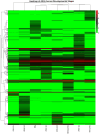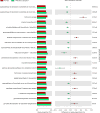Dynamics of bacterial communities across developmental stages of the litchi stink bug, Tessaratoma javanica
- PMID: 40781242
- PMCID: PMC12334609
- DOI: 10.1038/s41598-025-00598-y
Dynamics of bacterial communities across developmental stages of the litchi stink bug, Tessaratoma javanica
Abstract
The Litchi stink bug, Tessaratoma javanica (Thunberg) (Hemiptera: Tessaratomidae), is a major insect pest of litchi in India. Insect-associated bacteria play significant roles in their growth and development. We studied the bacterial communities linked to T. javanica using 16 S rRNA amplicon sequencing and predicted the functions of associated bacterial communities. The findings revealed that bacterial communities significantly differ across the developmental stages of T. javanica. The primary bacterial phyla across all developmental stages linked to T. javanica were Proteobacteria, Firmicutes, Bacteroidota, Actinobacteria, Patescibacteria, and Nitrospirota. Class Gammaproteobacteria predominated in first and 4th nymphal instars, and adult females, whereas Bacilli dominated the gut of the 3rd, and 5th nymphal instars of T. javanica. Ligilactobacillus apodemi, Staphylococcus xylosus, and Pseudomonas furukawaii were identified as the predominant bacterial species associated with T. javanica. The peak bacterial diversity was observed in the 5th nymphal instar and the lowest in the 1st nymphal instar. The observed changes between growth and developmental stages indicate that bacterial communities are dynamic and perpetually developing to meet the metabolic functions of T. javanica. Comprehending these interactions will improve our understanding of the ecological relationship with this pest and assists in developing and implementing efficient biological control plans for its management.
Keywords: 16S rRNA amplicon sequencing; Bacterial microbiota; Diversity; Litchi stink bug.
© 2025. The Author(s).
Conflict of interest statement
Declarations. Competing interests: The authors declare that they have no known competing financial interests or personal relationships that could have appeared to influence the work reported in this paper. Consent to participate: Not applicable Consent for publication: Not applicable Code availability: Not applicable
Figures






Similar articles
-
Substantially altered bacterial diversity associated with developmental stages of litchi stink bug, Tessaratoma javanica (Thunberg) (Hemiptera: Tessaratomidae).Heliyon. 2024 Jun 5;10(11):e32384. doi: 10.1016/j.heliyon.2024.e32384. eCollection 2024 Jun 15. Heliyon. 2024. PMID: 38961890 Free PMC article.
-
Comparative analysis of Spodoptera frugiperda (J. E. Smith) (Lepidoptera, Noctuidae) corn and rice strains microbiota revealed minor changes across life cycle and strain endosymbiont association.PeerJ. 2024 Apr 12;12:e17087. doi: 10.7717/peerj.17087. eCollection 2024. PeerJ. 2024. PMID: 38623496 Free PMC article.
-
Characterizing the seminal microbiota in mature rams managed on divergent planes of nutrition, and their male offspring.J Anim Sci. 2025 Jan 4;103:skaf171. doi: 10.1093/jas/skaf171. J Anim Sci. 2025. PMID: 40371922
-
Do we need a standardized 16S rRNA gene amplicon sequencing analysis protocol for poultry microbiota research?Poult Sci. 2025 Jul;104(7):105242. doi: 10.1016/j.psj.2025.105242. Epub 2025 May 1. Poult Sci. 2025. PMID: 40334389 Free PMC article. Review.
-
Urinary microbiota and bladder cancer: A systematic review and a focus on uropathogens.Semin Cancer Biol. 2022 Nov;86(Pt 3):875-884. doi: 10.1016/j.semcancer.2021.12.010. Epub 2022 Jan 1. Semin Cancer Biol. 2022. PMID: 34979272
References
-
- Srivastava, K. & Choudhary, J. S. Pests and their management in Litchi. Trends Hortic. Entomol., 719–734. (2022).
-
- Kumar, H. & Singh, G. Biology of litchi bug, Tessaratoma javanica Thunberg (Hemiptera: Pentatomidae) on litchi. Pantanagar J. Res.5(1), 17–20 (2007).
-
- Choudhary, J. S., Prabhakar, C. S., Moanaro, Das, B. & Kumar, S. Litchi stink bug (Tessaratoma javanica) outbreak in Jharkhand, India, on litchi. Phytoparasitica41(1), 73–77 (2013).
-
- Parveen, S., Choudhary, J. S., Thomas, A. & Ramamurthy, V. V. Biology, morphology and DNA barcodes of Tessaratoma javanica (Thunberg)(Hemiptera: Tessaratomidae). Zootaxa3936(2), 261–271 (2015). - PubMed
-
- Mondal, M. F., Ahmed, J., Hassan, K. & Khan, M. A. M. First report of litchi stink bug (Tessaratoma Javanica Thunberg) outbreak in Bangladesh. Int. J. Trop. Insect Sci.41, 383–387 (2021).
MeSH terms
Substances
LinkOut - more resources
Full Text Sources

